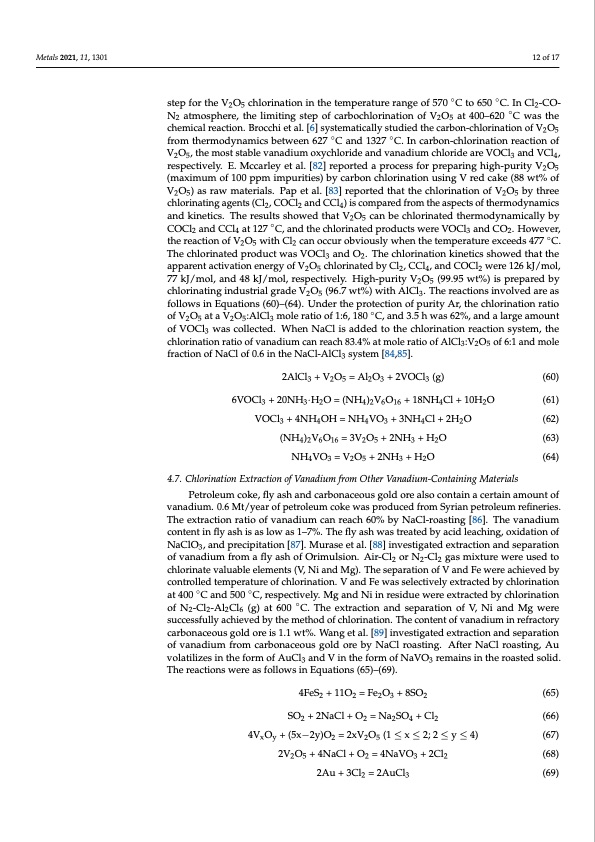
PDF Publication Title:
Text from PDF Page: 012
Metals 2021, 11, 1301 12 of 17 step for the V2O5 chlorination in the temperature range of 570 ◦C to 650 ◦C. In Cl2-CO- N2 atmosphere, the limiting step of carbochlorination of V2O5 at 400–620 ◦C was the chemical reaction. Brocchi et al. [6] systematically studied the carbon-chlorination of V2O5 from thermodynamics between 627 ◦C and 1327 ◦C. In carbon-chlorination reaction of V2O5, the most stable vanadium oxychloride and vanadium chloride are VOCl3 and VCl4, respectively. E. Mccarley et al. [82] reported a process for preparing high-purity V2O5 (maximum of 100 ppm impurities) by carbon chlorination using V red cake (88 wt% of V2O5) as raw materials. Pap et al. [83] reported that the chlorination of V2O5 by three chlorinating agents (Cl2, COCl2 and CCl4) is compared from the aspects of thermodynamics and kinetics. The results showed that V2O5 can be chlorinated thermodynamically by COCl2 and CCl4 at 127 ◦C, and the chlorinated products were VOCl3 and CO2. However, the reaction of V2O5 with Cl2 can occur obviously when the temperature exceeds 477 ◦C. The chlorinated product was VOCl3 and O2. The chlorination kinetics showed that the apparent activation energy of V2O5 chlorinated by Cl2, CCl4, and COCl2 were 126 kJ/mol, 77 kJ/mol, and 48 kJ/mol, respectively. High-purity V2O5 (99.95 wt%) is prepared by chlorinating industrial grade V2O5 (96.7 wt%) with AlCl3. The reactions involved are as follows in Equations (60)–(64). Under the protection of purity Ar, the chlorination ratio of V2O5 at a V2O5:AlCl3 mole ratio of 1:6, 180 ◦C, and 3.5 h was 62%, and a large amount of VOCl3 was collected. When NaCl is added to the chlorination reaction system, the chlorination ratio of vanadium can reach 83.4% at mole ratio of AlCl3:V2O5 of 6:1 and mole fraction of NaCl of 0.6 in the NaCl-AlCl3 system [84,85]. 2AlCl3 + V2O5 = Al2O3 + 2VOCl3 (g) (60) 6VOCl3 + 20NH3·H2O = (NH4)2V6O16 + 18NH4Cl + 10H2O (61) VOCl3 + 4NH4OH = NH4VO3 + 3NH4Cl + 2H2O (62) (NH4)2V6O16 = 3V2O5 + 2NH3 + H2O (63) NH4VO3 = V2O5 + 2NH3 + H2O (64) 4.7. Chlorination Extraction of Vanadium from Other Vanadium-Containing Materials Petroleum coke, fly ash and carbonaceous gold ore also contain a certain amount of vanadium. 0.6 Mt/year of petroleum coke was produced from Syrian petroleum refineries. The extraction ratio of vanadium can reach 60% by NaCl-roasting [86]. The vanadium content in fly ash is as low as 1–7%. The fly ash was treated by acid leaching, oxidation of NaClO3, and precipitation [87]. Murase et al. [88] investigated extraction and separation of vanadium from a fly ash of Orimulsion. Air-Cl2 or N2-Cl2 gas mixture were used to chlorinate valuable elements (V, Ni and Mg). The separation of V and Fe were achieved by controlled temperature of chlorination. V and Fe was selectively extracted by chlorination at 400 ◦C and 500 ◦C, respectively. Mg and Ni in residue were extracted by chlorination of N2-Cl2-Al2Cl6 (g) at 600 ◦C. The extraction and separation of V, Ni and Mg were successfully achieved by the method of chlorination. The content of vanadium in refractory carbonaceous gold ore is 1.1 wt%. Wang et al. [89] investigated extraction and separation of vanadium from carbonaceous gold ore by NaCl roasting. After NaCl roasting, Au volatilizes in the form of AuCl3 and V in the form of NaVO3 remains in the roasted solid. The reactions were as follows in Equations (65)–(69). 4FeS2 + 11O2 = Fe2O3 + 8SO2 (65) SO2 +2NaCl+O2 =Na2SO4 +Cl2 (66) 4VxOy +(5x−2y)O2 =2xV2O5 (1≤x≤2;2≤y≤4) (67) 2V2O5 + 4NaCl + O2 = 4NaVO3 + 2Cl2 (68) 2Au + 3Cl2 = 2AuCl3 (69)PDF Image | Extraction of the Rare Element Vanadium

PDF Search Title:
Extraction of the Rare Element VanadiumOriginal File Name Searched:
metals-11-01301.pdfDIY PDF Search: Google It | Yahoo | Bing
Product and Development Focus for Salgenx
Redox Flow Battery Technology: With the advent of the new USA tax credits for producing and selling batteries ($35/kW) we are focussing on a simple flow battery using shipping containers as the modular electrolyte storage units with tax credits up to $140,000 per system. Our main focus is on the salt battery. This battery can be used for both thermal and electrical storage applications. We call it the Cogeneration Battery or Cogen Battery. One project is converting salt (brine) based water conditioners to simultaneously produce power. In addition, there are many opportunities to extract Lithium from brine (salt lakes, groundwater, and producer water).Salt water or brine are huge sources for lithium. Most of the worlds lithium is acquired from a brine source. It's even in seawater in a low concentration. Brine is also a byproduct of huge powerplants, which can now use that as an electrolyte and a huge flow battery (which allows storage at the source).We welcome any business and equipment inquiries, as well as licensing our flow battery manufacturing.| CONTACT TEL: 608-238-6001 Email: greg@salgenx.com | RSS | AMP |